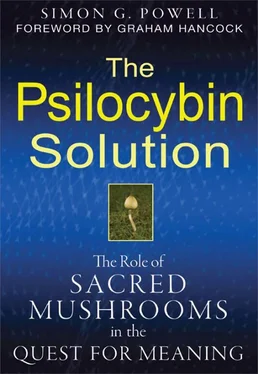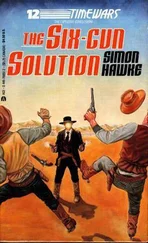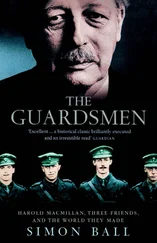If, as seems highly probable, the major pattern-inducing properties of the Universe are not accidental, then we might discern some will or intention lying at the very heart of Nature. We might wish to shake hands with Nature and say “nice work” or “good game.” I have to employ a modicum of humor here as the situation we are now in is somewhat bizarre. Because an accelerating flow of self-organizing information appears to be focused upon our planet, it must surely be directed toward some culmination point. What then will be the final output of this particular evolving part of the Universe? What on Earth is the point? Where are we being drawn? What pattern has yet to evolve or be resolved?
Before we take a final look at the implications of the psilocybin experience for an understanding of “the meaning of it all,” let me summarize the heady ideas outlined in the past few chapters in the form of a vivid visual metaphor. This metaphor embraces everything of significance in the computational/informational paradigm, allowing us to view everything at once, in one great image. So, relax and get your mind’s eye ready as I present to you the River of Life thought experiment. (I should point out that I came up with this metaphor independently of Richard Dawkins, who uses a somewhat similar metaphor in his book River out of Eden. )
Picture a big lake of still water. This is an informational void, endowed only with capacity and potential. All the myriad particles of the water can be likened to potential bits of information, though all are in the same uniform state. There is just still water, no forms or patterns whatsoever, nothing of interest, no dialogue-like flow of information or anything. Still, it is an initial state; the lake of formless water exists. You and I creatively imagine it and format it that way.
Now, take a monstrously big stick and begin to stir the lake. The stirring action corresponds to a law, or rule, or intent operating on the state of the lake water. Already, the stirring action begins to create currents, eddies, and vortices of turbulence. As you continue to stir the lake, ever more of these forms and patterns emerge in the water. Notice that the ripples, patterns, and waves that are forming and that flow across and beneath the surface of the lake are all facets of one whole entity—the entire lake. No one part of the water is isolated; rather, there is just one system of water swirling and slopping about. This is the fluidic, interconnected “informational stuff” of the lake that has been transformed from a featureless state to an informed state through the stirring action. The stirring action represents the rules or laws commanding the behavior of the water. If you cannot picture the water in the lake as an interconnected continuum, then scale the lake down to a bathtub of water. When you slosh the water around in a bath, it is clear that there is just one fluidic entity lapping about; no single region is isolated.
If we continue to stir the lake in a particular way, more and more complex patterns emerge. Let us also allow the water in the lake to gradually flow out and form a river, the leading edge of which contains the most organized patterns so far generated within the water. Swirling vortices are created that persist indefinitely. Now imagine these forms meeting with one another in the frothy forefront of the rushing river. Somehow they replicate themselves according to the precise manner in which we have done the stirring. So now we have a flowing river containing replicating patterns of information bearing definite language-like relations with one another. When these fluidic patterns meet, a kind of dialogue ensues in which the patterns inform one another, creating yet more diverse patterns.
We can add to the laws inherent in our stirring by incorporating new laws in the form of precisely shaped rocks over which the river flows (akin to constants). These rocks will further determine what kinds of forms arise in the water. As the river progresses over the contrived rocks, perhaps different types of swirls are generated, such that new patterns emerge even more complex than their predecessors. As the number of enduring patterns increase, so too will the amount of relations between them. And yet all forms remain part of the same integrated fluidic stuff. What one pattern of water does in one part of the river will eventually be felt everywhere else, for there is but one single interconnected substance in which all these events unfold.
Let a long span of time elapse. If we look to the leading edge of the river, we might find that the patterns that have now emerged are truly lifelike. Patterns that bear a specific and enduring role in relation to the rest of the water behave like organisms. It does not matter that these patterns consist only of water; what matters is their robust and self-sustaining structure and their formal relations to the other patterns around them and to the rest of the water.
Now we reach the climax of our metaphor. Picture the river cascading over a rocky cliff face, creating a waterfall. Take a close slow-motion look at the leading splashes, the leading edge of the creative flow of water. Elaborate humanoid life forms have now emerged, representative of the most evolved patterns of flowing information. Minds might eventually form within these creatures, minds being yet further patterns born out of the informational fluid, albeit of a highly evolved kind dependent on a huge amount of informational convergence. History foams into being across the face of rocks, cities flow in and out of existence, cultures come and go in the complex splashes emanating from the turbulent onrush of water. And at the very edge of the torrential flow we see informational entities like ourselves. And yes, such conscious beings might even come to wonder at the nature of the stuff around them. They might even conclude that it is all but one integrating confluential substance—that of fluidic information in process.
It is important to hold in mind that the eventually conscious property of the fluidic flow of information was determined by the precise way in which we stirred the water and the precise form of the rocks over which the river flowed. It was not accidental; rather, the flow was deliberately organized and configured so as to eventually produce consciousness, the most evolved kind informational pattern. In this way, the river of information has come to know itself and its origins. The river literally woke up to its true nature. A reflection of some sort arose.
Perhaps, then, the actual river of organic life that has spawned us has already attained its ultimate purpose, for we are the means by which Nature has become self-aware. Does this mean that we should now sit back comfortably because all is complete? Is the goal of Nature self-awareness of the kind we have already attained? Surely not. There must be more to it than that. I would surmise that the “climax” of reality has yet to become manifest, at least in our neck of the woods. After all, complex computer programs often yield a final output, this result depending upon what the user wanted from the program. In our river metaphor, this would mean that there would be a climactic state emerging at the bottom of the waterfall, a kind of final solution verily propelled and coerced into existence.
Because the information-integration processes displayed by our culture in the wake of evolving computer technology and computerized telecommunication systems shows no signs of abating and appears to be speeding up at an unprecedented rate, and because of the type of information accessed during the psilocybin experience, I believe that the destined output of the biosphere is something that human culture will eventually usher in. In other words, the “intent” of Nature is now being conveyed through the evolutionary development of human culture and human consciousness. If so, this implies that conscious human culture with its attendant technology represents the fulfillment of some kind of cosmic imperative. This is the sort of highly speculative idea taken up in the next chapter.
Читать дальше










